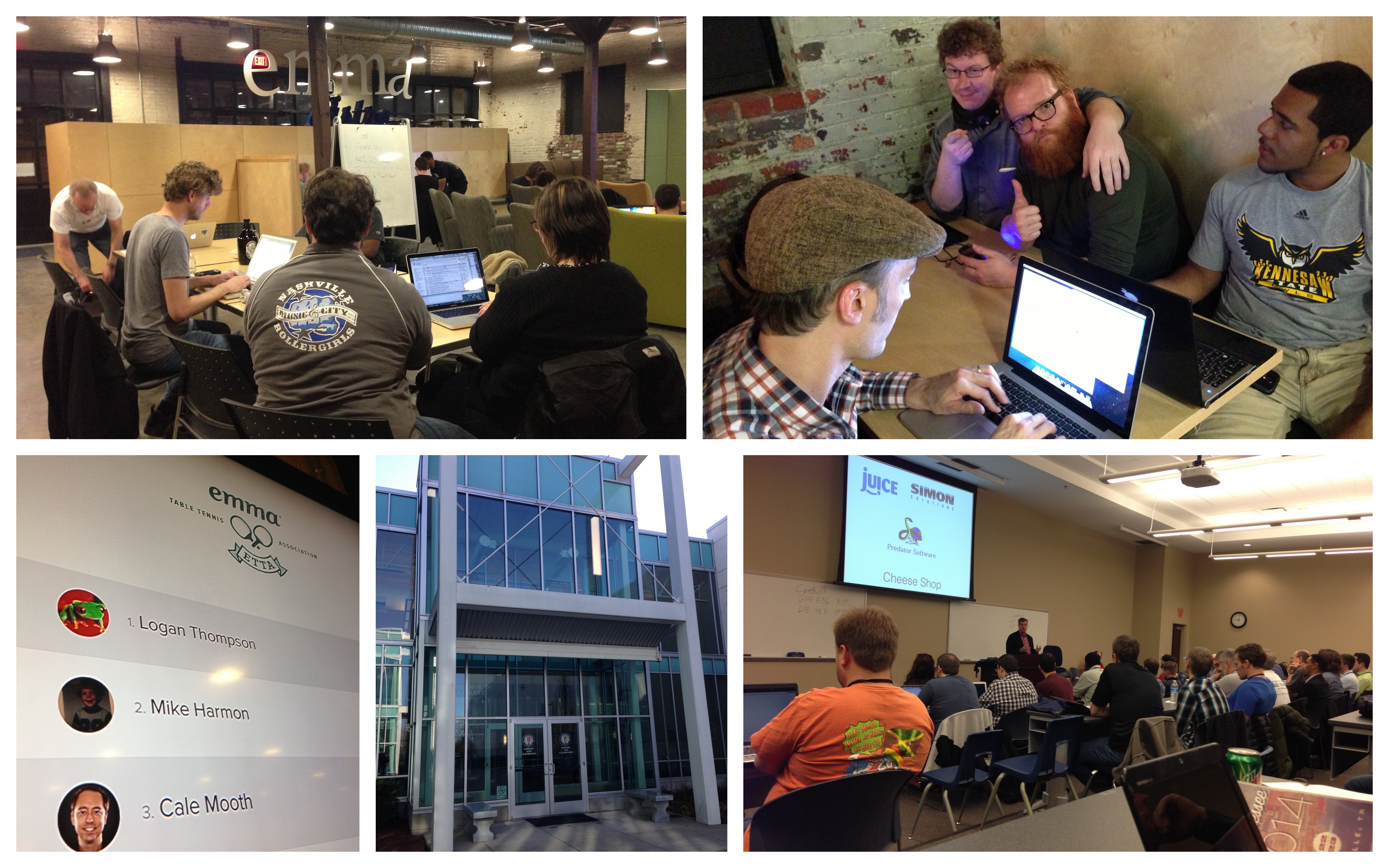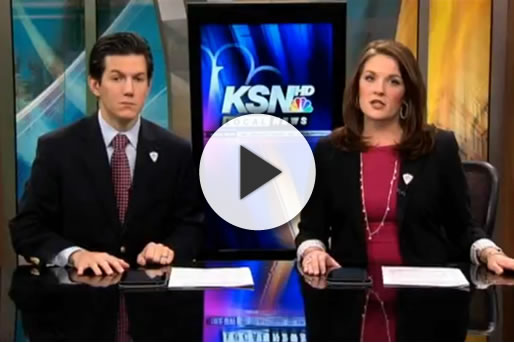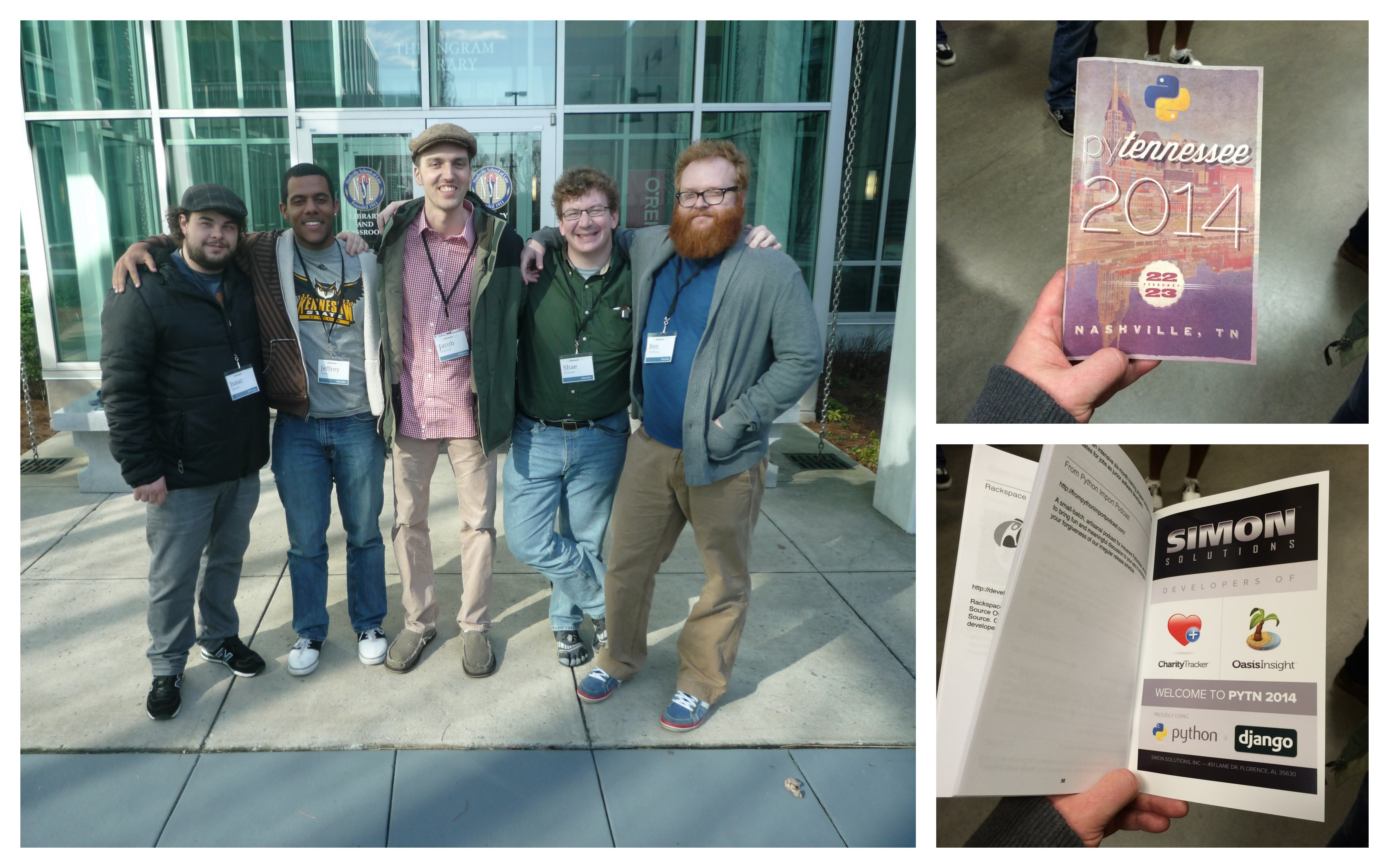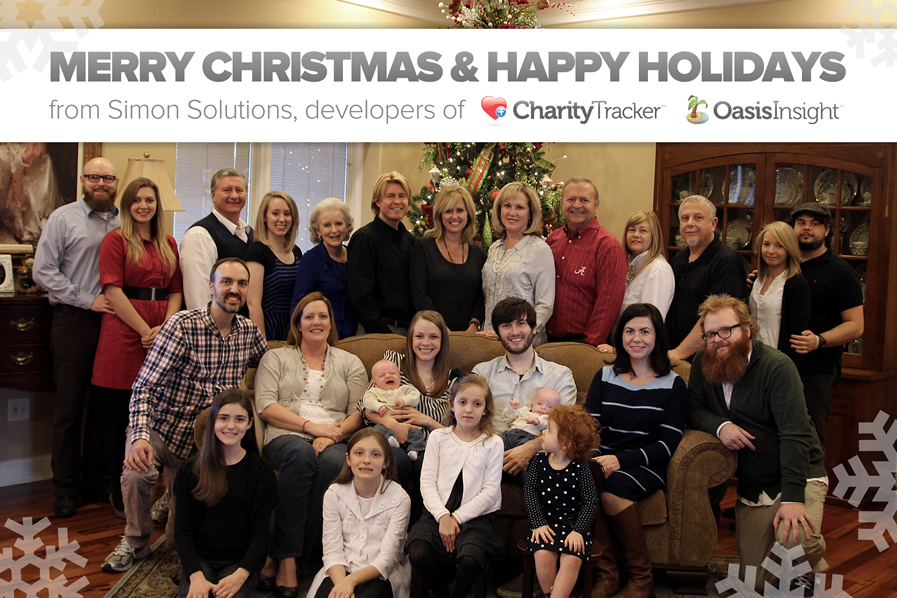March 10, 2014, 11:55 a.m.
·
0 comments
Over the course of the last seven years, we have dedicated ourselves to making CharityTracker a service that is helpful to you in your amazing work of assisting people in need.
We are excited to share that CharityTracker is now used in more than 700 cities! We would like to take this moment to thank you for your tireless and often unnoticed work. We are humbled and honored to serve you in your great effort.
As always, if there is something you need from us, please let us know.
Thank you,
Ben Stedman
CEO
Categories:
News
Feb. 25, 2014, 11:58 a.m.
·
0 comments
(pictured L-R, Isaac Simon, Jeffrey Allen, Jacob Senecal, Shae Erisson, Ben Stedman)
This past weekend, Simon Solutions was a proud sponsor of PyTennessee 2014, a conference in Nashville, TN for the popular computer programming language, Python. Python is an open source language used by our programmers as well as industry heavyweights such as Google, Yahoo, Mozilla and thousands of other companies.
The Simon Solutions development team was also very happy to have the opportunity to attend PyTennessee 2014 themselves.
The enthusiasm and diversity of attendees was mesmerizing. There were coders from all over the United States and even a classroom full of children anxiously setting up their computers to learn programming. During the keynote, Nashville's mayor, Karl Dean (pictured below), expressed his gratitude and excitement of seeing Nashville's tech community growing by leaps and bounds.

After each day of the conference, Emma, a Nashville-based email marketing company and co-sponsor of the conference, hosted sessions where programmers could contribute to the open source community in a group setting. Open source software is generally free for anyone to use and is maintained by programmers from all over the world. Without a doubt, the internet wouldn't be what it is today without open source software.
Needless to say, we can't wait for PyTennessee 2015! A very special thanks to Jason Myers and his team for organizing an awesome conference!
Categories:
Tech News
Feb. 14, 2014, noon
·
0 comments
Damage Control
Improper uses of disaster aid follow like day to night
FEBRUARY 14, 2014
by DANIEL J. SMITH, LAURA GRUBE
Natural disasters raise the threat of disease by disrupting water supplies and sewage systems. But they nearly always spread corruption throughout every political system that touches relief funds. That’s why the allegations against New Jersey governor Chris Christie—that he diverted Hurricane Sandy relief funds into advertising and marketing during his reelection campaign in 2013—are hardly surprising.
For instance, the state of Hawaii was recently asked to refund up to $4.2 million in disaster relief paid out after flooding and landslides all the way back in 2006. Hawaii officials allocated disaster relief funds to various construction projects that were unrelated to emergency relief. They also skipped mandatory competitive bidding processes when selecting contractors. The Department of Homeland Security’s inspector general’s report found that the state's Department of Design and Construction explicitly granted projects to specific contractors.
Then there’s Katrina. Even six years after the hurricane, the Federal Emergency Management Agency (FEMA) was still reviewing 154,000 cases of potential fraud involving $600 million that was mistakenly allocated to individuals who did not meet the requirements for assistance. The money had been allocated for disaster victims of the 2005 Hurricanes Katrina, Rita, and Wilma. Under political pressure to deliver results, FEMA officials omitted even basic property inspections and did not check whether an applicant’s insurance company had already covered the damage. Thousands of unqualified individuals improperly secured funds.
This on top of a 2013 report saying that nobody knows what happened to $700 million out of the $1 billion that the Department of Housing and Urban Development granted to Louisiana's Road Home program. More than 24,000 homeowners could not demonstrate that they used appropriately the $30,000 they each received to elevate and repair their homes.
The Katrina examples might have come down to relaxed protocols and human error, but evidence suggests that disaster aid is often distributed for reasons apart from reported losses and demonstrated need. Peter Leeson and Russell Sobel (2008) found that each additional $100 in per capita disaster assistance a state receives increases that state's average corruption level by over 100 percent.
It’s not hard to see why relief funds are ripe for corruption: Sudden injections of money meet a surge of demands and an urgent situation full of confusion; traditional protocols are often streamlined; applicants know their claims will receive little if any scrutiny.
Post-disaster contexts also draw political pressure. Those in charge of the funds are encouraged to open the spigot. In fact, Thomas Garrett and Russell Sobel (2003) found that states that are electorally strategic to the President are more likely to receive presidential disaster declarations. Garrett and Sobel also found that, prior to FEMA's reorganization under the Department of Homeland Security, states with representatives on FEMA oversight committees were more likely to receive disaster funds.
Private disaster relief—from churches, charities, and businesses—avoids many of these problems, beyond simply being more effective in general at addressing the local needs of disaster-stricken communities. Private aid is less susceptible to political corruption, and organizations have more incentive to ensure that funds are not dispersed inappropriately. Local private groups are also better situated to know the local community, the damage suffered, and the people in the community, and thus to recognize potential aid abuses.
For instance, following the 2011 tornado, College Heights Church in Joplin, MO, and other churches and charities in the Joplin area started using Charity Tracker to prevent abuse of private relief. Charity Tracker is a program that allows churches and charities to record assistance given to specific individuals. The system provides alerts if the same individual is requesting similar aid from multiple charities and churches in rapid succession, indicating potential abuse by the recipient.
Additionally, Charity Tracker allows churches and charities to share information on recipients to tailor assistance to their needs. One Joplin church leader told us that “you have a moral obligation to make sure that what is being donated, it goes to those who actually are . . . survivors of the tornado.” In Tuscaloosa, churches relied on the Tuscaloosa Prayer Network and Love, Inc.—two previously existing networks of pastors and churches—to avoid duplicating assistance to the same disaster victims.
Samaritan’s Purse, which sent both immediate disaster relief and home-rebuilding teams into New Orleans, Joplin, and Tuscaloosa (among other disaster-stricken areas), has case managers investigate every work case submitted to it for authenticity and need. They even include drug tests and credit checks to ensure that donations to their disaster-relief efforts are used as effectively as possible. Samaritan’s Purse often partners with local churches, such as the First Baptist Church in Tuscaloosa, in order to work with people who know the local community's residents and needs.
While FEMA struggled with transitioning disaster victims from trailers intended to be only temporary living quarters following Hurricane Katrina, 90 percent of the estimated 5,000–7,000 displaced households from the Joplin tornado were accommodated by families, friends, and even welcoming church and charity members, mitigating the potential for long-term abuse of disaster relief. Additionally, disaster victims seeking refuge with private citizens received friendship and assistance to address the deeper emotional scars of the storm, and they potentially avoided exposing children to some of the health and social side effects associated with FEMA trailer parks.
While the recent wave of reports uncovering new abuses of disaster aid are disturbing, they weren’t unexpected. The good news is that there’s a superior alternative already at work.
Here's a link to the original article.
Categories:
Press
Feb. 4, 2014, 2:12 p.m.
·
0 comments

Thanks to KSN TV (Joplin, MO) for covering how CharityTracker is being used in Joplin, Missouri by the Joplin Area Ministerial Alliance to serve organizations such as Souls Harbor of America and Joplin Family Worship Center! These outreach organizations are shining examples of how working together can make a huge impact in your community.
Categories:
Press
Jan. 21, 2014, 6 a.m.
·
4 comments
With custom-built reports we can help your organization improve efficiency and get even more value out of our case management software.
Do you often run multiple reports only to have to combine the information into a single report later? If so, you may be interested in a custom-built Report.
Show us an example of what you need a report to look like and our development team can create that report and make it available to only your agency or your entire network.
We can produce reports in several common file formats such as EXCEL spreadsheets, PDF files, or simply display them in your browser like the standard built-in reports. We can even add visual enhancements like graphics and charts at your request.
We'd love to make your life a little easier. Give us a call at 1.888.764.0633 or send us an email to let us know your needs.
There is a one-time fee associated with a custom-built report. Prices start at $150 and are billed on a per-hour basis. Our technical support staff would be happy to discuss your specific needs with you and provide a quote for the proposed customizations.
Categories:
Info
Dec. 25, 2013, noon
·
0 comments
BIRMINGHAM, Ala. (AP) — Charities in northwest Alabama had a problem after Hurricane Katrina blasted the northern Gulf Coast in 2005: They didn't know how to keep track of thousands of people who were suddenly on the move and seeking help far from their homes in Louisiana, Mississippi and Alabama.
A collaboration between community workers and computer programmers resulted in a system that is now being used to keep track of thousands of charity recipients in about 680 cities nationwide this Christmas season.
Developed by Simon Solutions Inc. in Florence, CharityTracker is one of about 30 software tools used by U.S. homeless shelters, services agencies, soup kitchens, faith-based groups and community organizations to keep up with the thousands of needy people who seek assistance every day. An agency can sign up and use the Web-based system for as little as $15 a month.
The U.S. Department of Housing and Urban Development requires agencies to share information electronically if they receive government funding, and other software systems have wider use in certain areas than CharityTracker. But Cathy Easley, a United Way administrator in Charleston, S.C., said CharityTracker is simple enough that even occasional users can work it and robust enough to let agencies share detailed information that helps people.
For example, she said, someone might ask for utility assistance at an agency that doesn't pay for power bills. Once a client signs a release allowing information to be shared, the agency can upload a copy of the power bill, which can then be seen by another organization that can help out, Easley said.
"It has really transformed how our community, agencies and churches work together and how we are better able to serve clients by using it," said Easley, director of integrated community systems for Trident Unite Way. About 90,000 names are in the Charleston-area database, which is used about 200 organizations, she said.
Simon Solutions President Mike Simon said his company tries to differentiate its system from others with good customer service and a user interface that's so simple that an elderly church volunteer could pick up the basics in a few minutes of training.
"It is very, very volunteer friendly," he said.
Part of the reason goes back to the way the system was born in the months after Katrina.
The hurricane inundated New Orleans with floodwaters after levees failed, and thousands of people lost their homes in Mississippi and Alabama because of the high winds and storm surge. Many people fled north after being left homeless by the storm, and some of them wound up in northwest Alabama.
Small-town church volunteers and charity agencies that were using notebooks or index cards to track aid recipients suddenly were faced with large numbers of people seeking assistance, and they needed a way to keep tabs on what type of aid individuals were receiving to avoid duplication. They also dreamed of an easy way to communicate with workers in other organizations to help determine what sort of assistance may be available for specific needs, like someone who needed transportation or a job.
"They were pretty perplexed," said Simon. "They were worried that the right resources were not getting into the right hands."
Simon Solutions already was located in the Shoals area of northwest Alabama, and agencies asked the company for help in developing software to help track people and to make it simpler to get aid to the needed. The goal was to build a computer database in which agencies could store information and share it, a key requirement for avoiding duplication of services.
The company developed a regional system called SEANtracker, or Shoals Emergency Assistance Network tracker. Word spread and software engineers used it as the basis for CharityTracker. Large groups of users are now located in cities including Charleston, Joplin, Mo., and Austin, Texas, said Simon.
Michelle Farley, director of a Birmingham-based consortium of assistance agencies called One Roof, said her agency and most others in Alabama use a larger, competing system called ServicePoint, which functions similarly to CharityTracker and other software systems that let organizations store and share information about aid recipients.
To improve its product, CharityTracker has added technology that will allow assistance agencies to add information into their databases by simply scanning a recipient's identification card.
Charity groups need some sort of database to avoid the drain of providing duplicate assistance, Farley said, but they also need information that can help them operate most efficiently.
"Churches don't want to continue giving people money for utilities monthly if what they really need is weather stripping," said Farley.
Thanks to Jay Reeves from the Associated Press for covering our story! This article was quite a wonderful gift to arrive on Christmas morning. The story was reprinted by The Washington Post, The San Francisco Chronicle, The Minneapolis Star Tribune, ABC News, Bloomberg News, and many others. Here's a link to the original article.
Categories:
Press
Dec. 17, 2013, noon
·
0 comments
At Simon Solutions we are beyond grateful to have the opportunity to provide our clients with tools to heal people’s lives and make a real difference in the world.
We all know that charitable giving and volunteerism greatly increase during the holiday season.
Only a few are strong enough to be a hero every day of the year.
We salute you!
Please share with us your stories of how using CharityTracker and Oasis Insight has been helpful in your work. You can leave a comment here on our blog or send your story to us at stories@simonsolutions.com
Please send us your office/crew photos and we will proudly share them to our social media sites.
Merry Christmas & Happy Holiday from Simon Solutions!
Categories:
Info
Dec. 8, 2013, noon
·
0 comments
Florence-based CharityTracker's new feature allows churches, nonprofits to record data with 1 scan
By Lucy Berry
FLORENCE, Alabama – A technology developed by Florence-based Simon Solutions to help organizations keep track of client intake and reporting data now allows assistance workers to record information with just one scan.
CharityTracker, which announced Friday that scanner and barcode technology is now being offered to use with the CharityTracker Plus product version, gives clients the option to open case files and add assistance records with a couple of scans.
Customers can also print and use scanned ID cards with the product. Officials hope the new features will streamline intake processes and cut down on the time workers spend on manual data entry.
"We believe the barcode scanning option will help charitable organizations serve their clients faster and with greater accuracy," said Simon Solutions Chief Executive Officer Ben Stedman.
First implemented in northwest Alabama in 2007, CharityTracker has networks in 678 cities and recorded more than $150,000,000 in assistance spending since its introduction six years ago.
Simon Solutions, which opened in early 2006, developed the CharityTracker after being approached by the United Way of Northwest Alabama to create a system that would link caregivers in the event of a future emergency.
The online service is now used by faith-based and community nonprofit organizations, churches and government agencies.
Here's a link to the original article.
Categories:
Press
We are pleased to announce that Simon Solutions now offers our clients the ability to use scanner and barcode technology with our products, CharityTracker Plus and Oasis Insight Plus.
The newly available features will enable clients to open cases and add assistance records with just a couple of scans, as well as print and use scannable ID cards. This will streamline intake processes and greatly reduce data entry time for assistance workers.
While the software is flexible and can work with many different models of scanners, we have tested and confirmed 100% compatibility with the Motorola LI2208 and Symbol LS4208. Both are widely available scanners and can be independently purchased from your retailer of choice.
Here’s how it works. (Be sure to view in full screen)
Categories:
News
Tech News
Nov. 27, 2013, noon
·
0 comments
Your tax money: Is helping the Myrtle Beach homeless worth it?
Posted: Nov 27, 2013 3:56 PM CDT
Updated: Nov 28, 2013 5:16 AM CDT
MYRTLE BEACH, SC - In 2013, the South Carolina Coalition for the Homeless counted more than 6,000 homeless people across the state. Statistics show that Horry County ranked among the top three counties with the greatest number of homeless. Helping the homeless is a challenge for many cities including Myrtle Beach. In the past, various groups used tax dollars to provide free services for those in need. The city of Myrtle Beach hopes to cut expenses by changing the way they help the homeless.
Charles Miller said he is happy to have a roof over his head and food on the shelves.
"I was unemployed in North Carolina for several months and ended up losing everything that I had" said Miller.
Miller lives at Street Reach, a shelter for those in need, which is a stark difference from 2 years ago when the homeless established tent cities. The encampment was on private property and drew the attention of tourists as well as Horry County police. Officers arrested nearly half a dozen people for trespassing. The move sparked protests, grabbed headlines and made the issue of homelessness a top priority for leaders in Myrtle Beach.
"Basically we want to move as many of the homeless as we can out of this community" said John Rhodes, Myrtle Beach mayor. "Being a tourist location we don't need homeless walking up and down the streets."
In an effort to clean up the city's image and remove the homeless from the streets, city officials gathered nearly 60 church groups, non-profit agencies and other organizations that served those in need. Together, they identified ways to improve services to the homeless and reduce duplicating resources.
"We have homeless people that come to one location and get groceries and go back to their camp and then go to another location and get more groceries" said Rhodes.
Mayor Rhodes said the free food along with clothes and shelter came at the expense of taxpayers. Budget information requested from the city of Myrtle Beach showed that in 2011 CASA and Street Reach received a combined $70,000 to help the homeless while $20,000 was given to Myrtle Beach Haven. In total that year, taxpayers spent $90,000 to offer certain services for those in need. The next year, 2012, CASA no longer existed but the city provided $50,000 in funding to the Center for Women and Children and $40,000 went to Street Reach. In addition, Myrtle Beach Haven received $10,000 more than the previous year, said Mark Kruea, spokesperson for the city of Myrtle Beach. After examining those numbers, city leaders looked to consolidate services and cut back expenses by forming an umbrella organization to help the homeless, New Directions.
"New Directions is an organization that was established to be a direction for change in the way we serve the people in need in our community" said Kathy Jenkins, Exec.Director for New Directions.
Jenkins said what makes the agency different is it's philosophy for helping the homeless.
"We are no longer going to provide a bed to sleep and a meal to eat" said Jenkins. "We are going to provide a plan and assistance to help people overcome their obstacles and get back into the workforce and become self-sufficient."
Jenkins said part of their plan includes Street Reach Enterprises. The faith-based program provides, food, shelter, skills training and employment services. Miller manages the shelters kitchen and hopes to find work in the local restaurant industry.
"I get up around 5:30am and get breakfast going and then after breakfast I go into cooking lunch where I usually serve about 30 to 35 people" said Miller.
Jenkins said typically Street Reach holds 55 males and 15 female residents. The agency uses an identification system know as "Charity Tracker" to monitor clients.
"This way we can track who our people are that need assistance, what sort of assistance do they need and do they truly want assistance or are they just trying to use the system" said Jenkins.
City leaders said they expect the change in the culture of homelessness in Myrtle Beach to take time and money. In the end, they hope their efforts save tax dollars and help lead the homeless in a new direction.
"We want to do everything we can to help the homeless" said Rhodes. But that homeless person that is walking down the streets that may have a pack of cigarettes in their hands and cell phone in the other hand who is not going to work and is not going to try and get a job. They need to go to another town."
For 2013, the Myrtle Beach City Council committed $121,000 to New Directions, said Kruea. He said they also allocated $65,000 in grant money for capital projects such as shelters improvements. Jenkins said the agency is still in the beginning phases but the overall goal is to use the funds to help the homeless rebuild their lives.
Here's a link to the original article.
Categories:
Press








